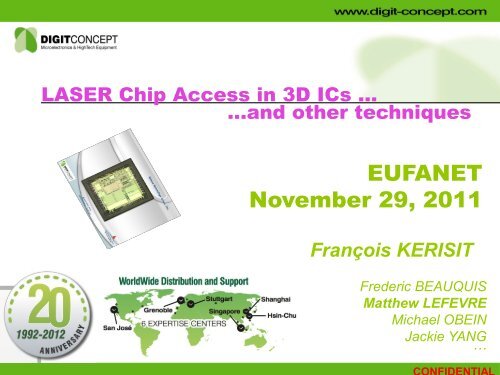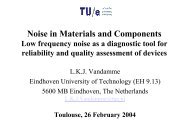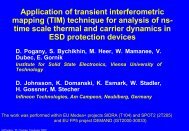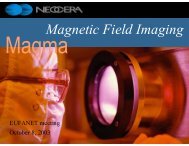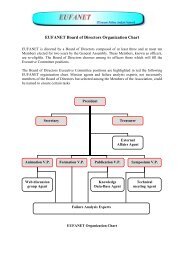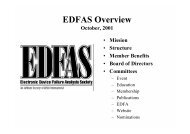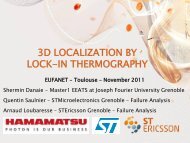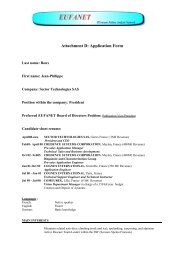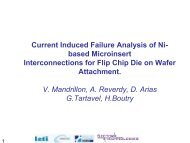confidential - EUFANET
confidential - EUFANET
confidential - EUFANET
You also want an ePaper? Increase the reach of your titles
YUMPU automatically turns print PDFs into web optimized ePapers that Google loves.
LASER Chip Access in 3D ICs …<br />
…and other techniques<br />
<strong>EUFANET</strong><br />
November 29, 2011<br />
François KERISIT<br />
Frederic BEAUQUIS<br />
Matthew LEFEVRE<br />
Michael OBEIN<br />
Jackie YANG …
AGENDA<br />
-<br />
-<br />
-<br />
Why open a component?<br />
4 ways of decapsulation<br />
-<br />
ACID<br />
-<br />
LASER<br />
-<br />
PLASMA/PLASER<br />
-<br />
MECHANICAL<br />
Mix of techniques<br />
-<br />
New 2D Challenges<br />
-<br />
3D Challenges
Why open a component?<br />
§<br />
Now, you have some data about your<br />
defect<br />
§<br />
SQUID, GMR<br />
§<br />
Thermal 3D<br />
§<br />
…<br />
and you want see the<br />
defect
Why open a component?<br />
§<br />
§<br />
§<br />
§<br />
Make the chip visible<br />
§<br />
Front side<br />
§<br />
Back side<br />
Make bondings accessible<br />
See all connections<br />
Find contaminants<br />
§ …<br />
4 usual techniques are possible in this day<br />
but depend on purpose<br />
Picture property : LaMIP NXP CAEN / DIGIT CONCEPT
AGENDA<br />
-Why open a component?<br />
-<br />
-<br />
4 ways of decapsulation<br />
-<br />
ACID<br />
-<br />
LASER<br />
-<br />
PLASMA/PLASER<br />
-<br />
MECHANICAL<br />
Mix of techniques<br />
-<br />
New 2D Challenges<br />
-<br />
3D Challenges
CHIP ACCESS<br />
4 MAIN WAYS AND ONE MORE<br />
⬆ SESAME ACID<br />
ACIDS<br />
LASER<br />
⬆ SESAME LASER<br />
⬇FRONT SIDE<br />
⬆BACK SIDE<br />
⬆ ASAP-1 UC<br />
⬆ ULTRAPOL-ADV<br />
⬆ SESAME PLASER<br />
⬆ CAN OPENER<br />
MECHANICAL<br />
PLASMA<br />
⬆ DIP OPENER<br />
⬆ MICRO ABRASIVE<br />
BLASTING<br />
⬆ SESAME PLASMA
Papers about these techniques<br />
•<br />
EPTC 2006<br />
•<br />
ANADEF 2006<br />
•<br />
ESREF 2007<br />
•<br />
ANADEF 2008<br />
•<br />
ESREF 2008<br />
•<br />
ISTFA 2008<br />
•<br />
ANADEF 2010<br />
•<br />
IPFA 2010<br />
•<br />
ESREF 2011<br />
•<br />
ISTFA 2011<br />
•<br />
EPTC 2011 …
AGENDA<br />
-<br />
-<br />
-<br />
Why open a component?<br />
4 ways of decapsulation<br />
-<br />
ACID<br />
-<br />
LASER<br />
-<br />
PLASMA/PLASER<br />
-<br />
MECHANICAL<br />
Mix of techniques<br />
-<br />
New 2D Challenges<br />
-<br />
3D Challenges<br />
• +10°C for 270s<br />
No observable attack or corrosion on the<br />
lead finger coating or die pads, wires very<br />
uniform with a measured diameter of<br />
~19.5mm and no evidence of thinning or<br />
pitting.
ACID<br />
§<br />
§<br />
§<br />
§<br />
§<br />
Drop technique or automated decapsulator<br />
Positive or Negative pressure<br />
90°C<br />
Nitric acid (HNO3) up to<br />
255°C<br />
Sulfuric acid (H2SO4) up to<br />
100°C<br />
Acid mix up to<br />
Picture property : DIGIT CONCEPT
ACID Temperature …<br />
255°C<br />
IMAPS2003<br />
85°C<br />
75°C<br />
44°C<br />
27°C<br />
15°C<br />
10°C
Temperature …<br />
255°C<br />
85°C<br />
75°C<br />
IMAPS2011<br />
ISTFA2011<br />
44°C<br />
Copper :<br />
90% Fuming HNO3 / H2SO4 20%SO3<br />
mix 5/1 @ 10°C<br />
27°C<br />
15°C<br />
10°C
ACID : Exemples
AGENDA<br />
-<br />
-<br />
-<br />
Why open a component?<br />
4 ways of decapsulation<br />
-<br />
ACID<br />
-<br />
LASER<br />
-<br />
PLASMA/PLASER<br />
-<br />
MECHANICAL<br />
Mix of techniques<br />
-<br />
New 2D Challenges<br />
-<br />
3D Challenges
LASER ABLATION<br />
Regular LASER access today:<br />
1. Generate a cavity (pocket) in EMC (100µm to 200µm remaining EMC<br />
above chip).<br />
2. Opening is finished with a final acid touch (wet) or with plasma (dry).<br />
LASER 1064 nm<br />
RESIN ABLATION
PICTURE SUPERIMPOSITION<br />
jpeg PICTURE
LASER ABLATION : Examples
AGENDA<br />
-<br />
-<br />
-<br />
Why open a component?<br />
4 ways of decapsulation<br />
-<br />
ACID<br />
-<br />
LASER<br />
- PLASMA/PLASER<br />
-<br />
MECHANICAL<br />
Mix of techniques<br />
-<br />
New 2D Challenges<br />
-<br />
3D Challenges
PLASMA / PLASER<br />
SESAME Technology<br />
incorporates Mutual<br />
Patents / IP developed by<br />
CNES,<br />
DIGIT CONCEPT SA and<br />
BSET EQ<br />
(WO2008/090281)
A : LASER Ablation<br />
•<br />
STEP 1 : Place your component on XY table<br />
•<br />
STEP 2 : Importation of an X-ray or CSAM image<br />
•<br />
STEP 3 : Adjust X and Y with the Table<br />
•<br />
STEP 4 : Choose your recipe<br />
•<br />
STEP 5 : Start LASER Ablation
B : LASER/Plasma Ablation<br />
•<br />
Decrease of power LASER<br />
•<br />
Increase of power PLASMA<br />
•<br />
The hard coating is removed
CONFIDENTIAL<br />
C : Plasma O2/CF4<br />
•<br />
Removing of organic material with<br />
O2/CF4 plasma or pure O2<br />
•<br />
Approximately 15mn
D : FilerBlast<br />
•<br />
Removing of inorganic material with CO2 Liquid<br />
•<br />
Approximately 2 seconds
Step C & D repeats<br />
Plasma for 15mn<br />
Blast 2 seconds
BCB/Cu technology:<br />
Goal:<br />
Reach circuitry without degradation<br />
(BCB dielectric , Cu lines).<br />
Methodology:<br />
1. LASER cavity.<br />
2. Dry chemical (PLASMA) opening.<br />
Benefits:<br />
No degradation due acid use.<br />
LAT STM TOURS
AGENDA<br />
-<br />
-<br />
-<br />
Why open a component?<br />
4 ways of decapsulation<br />
-<br />
ACID<br />
-<br />
LASER<br />
-<br />
PLASMA/PLASER<br />
-<br />
MECHANICAL<br />
Mix of techniques<br />
-<br />
New 2D Challenges<br />
-<br />
3D Challenges
Mecanical : Milling<br />
§<br />
Micro-Milling machine equipped with collimator<br />
Die Topside<br />
Chip Coating<br />
Back Side Hole<br />
Package<br />
Pictures property : THALES / DIGIT CONCEPT
Mechanical : Milling …<br />
a 3D dream …<br />
Needed :<br />
-<br />
Z force Feedback<br />
-<br />
Measurement of warpage<br />
-<br />
Collimator for tilt<br />
-<br />
Live video for human control <br />
… and the Real World…
Mecanical : Polishing<br />
§<br />
Polishing machine equipped with a collimator<br />
Pictures property : DIGIT CONCEPT
AGENDA<br />
-<br />
-<br />
Why open a component?<br />
4 ways of decapsulation<br />
-<br />
ACID<br />
-<br />
LASER<br />
-<br />
PLASMA/PLASER<br />
-<br />
MECHANICAL<br />
-<br />
Mix of techniques<br />
-<br />
-<br />
New 2D Challenges<br />
3D Challenges
Cu WIRES with BCB passivation<br />
LASER and ACID :<br />
90% Fuming HNO3 / H2SO4 20%SO3<br />
mix 5/1 @ +10°C
LASER / Acid …<br />
Goal:<br />
Reach both dies without<br />
separating them, without damage<br />
on Cu wires and without acid leak.<br />
Methodology:<br />
1. LASER cavity.<br />
2. Wet chemical opening at low<br />
temperature.<br />
Benefits:<br />
Safe, fast, repeatable.<br />
Allow low temp wet chemical<br />
opening in a reasonable time.<br />
Decrease acid consumption.<br />
No acid leak.
LASER / Acid …<br />
Goal:<br />
Balls and stitch access without<br />
revealing all top die surface.<br />
Methodology:<br />
1. EMC removal from the side with<br />
LASER.<br />
2. Acid final touch to reveal balls<br />
and stitch.<br />
Benefits:<br />
Top die were nearly not revealed.<br />
LASER preparation allowed an<br />
accurate positioning of the chemical<br />
etch.
LASER / Plasma / Acid …<br />
LASER<br />
decapsulation:<br />
Plastic ablation<br />
down to passive<br />
die backside (Si).<br />
Wet chemical<br />
(HNO3)<br />
underfill etching<br />
down to active die.<br />
Plasma etching (Ar<br />
then SF6):<br />
Silicon etching down<br />
to passive die<br />
backside.<br />
Wet & dry<br />
etching,<br />
down to<br />
underfill.<br />
Xrays analysis, zoom on active die:<br />
No visible damage on 1st and 2nd<br />
interconnects.
Preparation for MAGNETIC/THERMAL<br />
Goal:<br />
Remove nearly all EMC above or<br />
below the chip (front side or<br />
backside). Around 100µm<br />
remaining EMC thickness allows<br />
better result for SQUID or for<br />
thermograph investigations.<br />
Benefits:<br />
Safe, fast, repeatable.<br />
Very useful when chips are not<br />
chemical compatible.
AGENDA<br />
- Questions …<br />
Please help me …<br />
I need 3D IC samples<br />
for my thesis.<br />
Michael and I are<br />
waiting for you !<br />
Thanks <br />
+10°C


